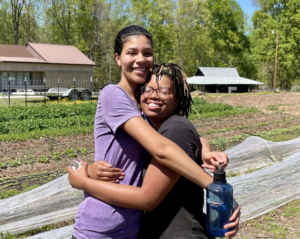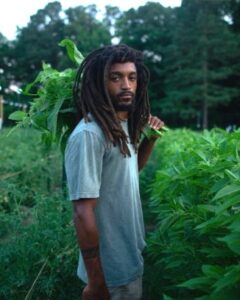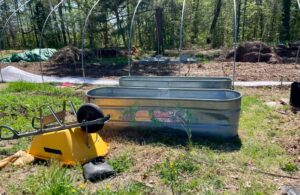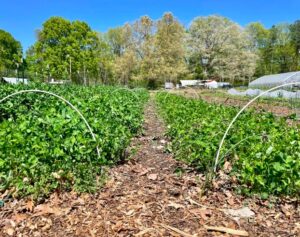
Friends and co-farmers Lila Jones (L) and Ashanti Brown (R) embrace after a day’s work at RealRoots. “We are returning to the land,” says Lila. “It’s time.” (Photo by Elena Durazo)
By Elena Durazo
“I refuse to politicize the process of growing food,” Mark Davis tells me with an assertive shake of his head. “I hold a strong disdain for that.”
Yet, he says, “what we are doing is inherently radical, in the context we are in.”
Davis is the founder and head farmer at RealRoots Food Systems LLC, an agricultural collective located in Mechanicsville, Virginia, 20 minutes outside of Richmond.
The “context” Davis is referring to is a time and place in which Black-owned farms, historically vital for providing food to urban neighborhoods and serving as vehicles for generational wealth-building, are rapidly disappearing.
RealRoots seeks to reverse this trend, gently, by showing how a community, in growing its own food, can reclaim what’s been lost: food sovereignty.
“What we are doing is creating a way to participate in the food system that is not currently available,” Davis says. At RealRoots, that means about 35 people farming a modest plot of land. “We’re small and that’s ok, because we’re doing what we’re doing exactly how we’re supposed to be doing it. We’re nourishing the land and our community.”
When asked about the impact of RealRoots’ activity on the surrounding areas, Mark lets out a dry chuckle. “I’m a realist. I know we’re not impacting the food desert in Mechanicsville or Richmond.”
“We’re growing on a quarter of an acre,” he explains. “Anybody who tells you they’re impacting widespread food insecurity while operating on that scale is trying to sell you something.”
“There’s no point right now in worrying about change on a bigger scale,” he says. “It happens organically at a small scale, no pun intended.”
He smiles warmly at the farmers working around us.
“We’re protecting each other.”

Mark Davis of RealRoots Food Systems (Photo courtesy of RealRoots)
His words resonate with a larger truth: Black farmers in Virginia and across the US today face unprecedented challenges from a combination of racial discrimination, involuntary land loss, and targeted, systemic disinvestment.
In 1910, Black farmers owned more than 16 million acres of land across the United States, an area slightly larger than the state of West Virginia. This was the height of Black farmland ownership as the next century saw massive dispossession of Black farms from state-sanctioned violence, intimidation, and lynching.
Black farmers were discriminated against by banks and financial institutions for loans, denied access to federal farm benefits, and subjected to persistent, coordinated, prejudice at the hands of USDA agents who restricted access to resources.
There are roughly 2 million farms in the US, a number that is steadily dropping. Of those farms, only 1.4% or 28,000 are Black-owned, despite Black folks comprising 14.2% of the population.
In Virginia, the numbers are even worse, with 42,000 farms, and roughly 2,000 owned by Black people. That’s an ownership rate of 0.07%, when Black Virginians make up ~20% of the state.

A wheelbarrow, raised planters, and a polytunnel skeleton show evidence of use from RealRoots’ farmers. (Photo by Elena Durazo)
These figures are based on 2014 USDA National Agricultural Statistics, but likely do not reflect the whole situation for Black farmers. The USDA NASS assigns niche categorizations to surveyees as tenant farmers, owner-operators, and non-operators based on distinctions in land rights and annual farm revenue. This system of classification makes small farmers more likely to be missed and Black farmers are more likely to be small-scale, meaning the true numbers .
As Mark rattles off these statistics, he grows more animated. “Whoever controls land controls sovereignty,” he declares. And “once you see who controls the food, you see who controls society.”

Ground-level: these rows of mixed vegetables will soon be ready for harvest. (Photo by Elena Durazo)
REGENERATIVE FOCUS
RealRoots practices regenerative agriculture, which means the farm focuses on minimal soil disturbance, composting, and preserving biodiversity. These harmonious land-tending practices are reflected in the social environment of the farm, as well.
Ashanti Brown, a RealRoots community member, recalls her thoughts about the farm at the beginning.
“I thought I’d get dirty and go home, but having a space to hone in on food, meals, and connection was transformative.”
“We are breaking the status quo of misery,” says Lila Jones, another community member, to the delight of the farmers around her.
She embraces Ashanti, who had earlier described disconnection from the land as a “curse” to be broken. At RealRoots, that is a guiding principle.
“We are returning to the land,” Lila says, smiling. “It’s time.”
